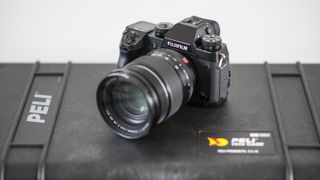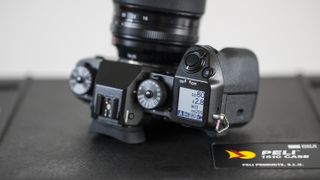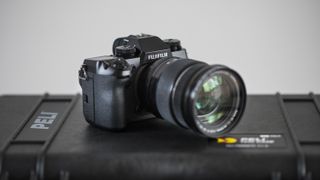The Fujifilm X-H1 is the new flagship X Series mirrorless camera, sitting above both the X-T2 and X-Pro2 in the range. As you'd expect for a camera aimed at serious enthusiast photographers, pros and videographers alike, the X-H1 features a comprehensive specification, including in-body image stabilization – a first for a Fujifilm camera,.
Features
- In-body image stabilization is a first for an X Series camera
- Cinema 4K at 24p
- Same 24.3MP APS-C X-Trans III CMOS sensor as X-T2
FUJIFILM X-H1 SPECS
Sensor: 24.3MP APS-C X-Trans III CMOS
Lens mount: Fujifilm X mount
Screen: 3.0-inch tilt-angle touchscreen, 1,040,000 dots
Burst shooting: 14fps
Autofocus: 325-point AF
Video: 4K
Connectivity: Wi-Fi, NFC and Bluetooth
Battery life: 310 shots
Weight: 673g
For the X-H1 Fujifilm has opted to stick with its 24.3MP APS-C X-Trans III CMOS sensor, which we first saw back in 2016 in the X-Pro2, and which has since found its way into the likes of the X-T2, X-T20and X100F. It's a sensor that's certainly impressed us in the past, but the relatively modest ISO range of 200-12,800 (expandable to 100-51,200) looks a little conservative compared to some potential rivals; the Nikon D500, for instance, has an extended sensitivity range that hits an ISO equivalent of 1,640,000.
If Fujifilm's engineers may have taken it easy in the sensor department, they've been busy elsewhere on the X-H1, and the big news is the arrival of in-body image stabilization (IBIS for short). While we've seen sensor-shift anti-shake technology on mirrorless cameras from Sony, Panasonic and Olympus, Fujifilm users have had to make do with the limited lineup of optical stabilized Fujinon lenses.
This all changes with the X-H1, with the new in-camera 5-axis system offering up to 5.5 stops of compensation with any lens not equipped with Fujifilm's OIS technology, which is great news if you've got a bag full of Fujifilm's lovely fast prime lenses. And you're not missing out if you want to pair an OIS lens with the X-H1 either, as the camera's IBIS will work in tandem with the OIS to provide a 3-axis system.
That's not all, as Fujifilm has also equipped the shutter with suspension for absorbing the shocks that can be generated when using the mechanical shutter, which should help reduce the risk of any additional camera shake.
While Fujifilm doesn't want the X-H1 to be seen as quite the hybrid video camera the Panasonic Lumix GH5 is considered to be, it has improved the camera's video recording capabilities over the X-T2. As well as offering 4K recording (3840 x 2160) at 30p, the X-H1 also offers DCI 4K (4096 x 2160) at up to 24p, while it also has the edge over the X-T2 when capturing Full HD footage, being capable of shooting at up to 120p compared to the X-T2's 60p.
Fujifilm has also doubled the bit rate on the X-H1 over the X-T2, increasing it from 100Mbps to 200Mbps, while it also offers a 400% dynamic range setting (approximately 12 stops) and an F-log shooting mode. There's also a new ETERNA film simulation setting which Fujifilm reckons is ideal for shooting movies; this simulates the look of cinematic film, creating understated colors and rich shadow tones.
The rear display can also be pulled outwards and away from the body when the camera is tilted on its side
The X-H1 gets a bigger electronic viewfinder than the X-T2, with the 2.36 million-dot OLED display in the X-T2 replaced by a 3.69 million-dot OLED unit, although the magnification is down a touch, from 0.77x to 0.75x.
As we first saw on the X-T2, the X-H1 has a 3.0-inch rear display with a double-jointed articulated movement which means the screen can also be pulled outwards and away from the body when the camera is tilted on its side. One noticeable change from the X-T2 is the arrival of touchscreen functionality.
In terms of connectivity, the X-H1 gets Bluetooth on top of Wi-Fi and NFC, and once you've paired the camera with your smartphone or tablet and downloaded the accompanying Fujifilm Camera Remote app you'll be able to easily transfer your images and share them on social media















No comments: